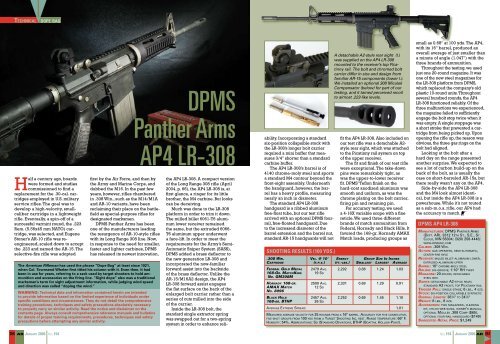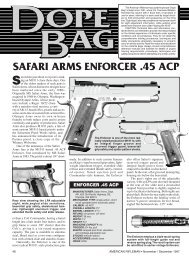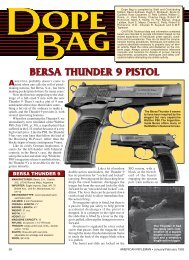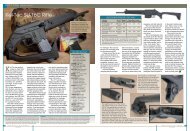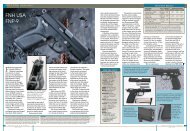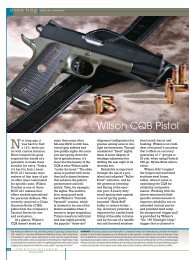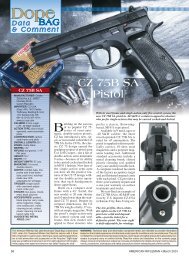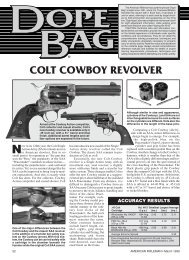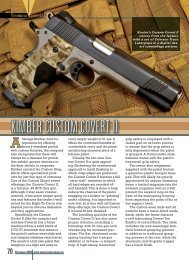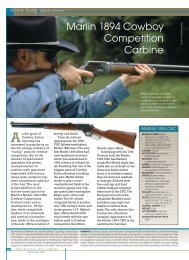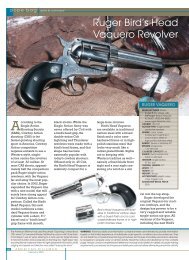reliability
DPMS Panther Arms AP4 LR-308 - The National Firearms Museum
DPMS Panther Arms AP4 LR-308 - The National Firearms Museum
- No tags were found...
Create successful ePaper yourself
Turn your PDF publications into a flip-book with our unique Google optimized e-Paper software.
Technical dope bag<br />
Half a century ago, boards<br />
were formed and studies<br />
commissioned to find a<br />
replacement for the .30-cal. cartridges<br />
employed in U.S. military<br />
service rifles. The goal was to<br />
develop a high-velocity, smallcaliber<br />
cartridge in a lightweight<br />
rifle. Eventually, a spin-off of a<br />
successful varmint round, the .223<br />
Rem. (5.56x45 mm NATO) cartridge,<br />
was selected, and Eugene<br />
Stoner’s AR-10 rifle was reengineered,<br />
scaled down to accept<br />
the .223 and named the AR-15. The<br />
selective-fire rifle was adopted<br />
first by the Air Force, and then by<br />
the Army and Marine Corps, and<br />
dubbed the M16. In the past few<br />
years, however, rifles chambered<br />
in .308 Win., such as the M14/M1A<br />
and AR-10 variants, have been<br />
reclaiming their place on the battlefield<br />
as special-purpose rifles for<br />
designated marksmen.<br />
DPMS Panther Arms has been<br />
one of the manufacturers leading<br />
the resurgence of AR-10-style rifles<br />
with its Long Range 308 line. Now,<br />
in response to the need for smaller,<br />
faster and lighter carbines, DPMS<br />
has released its newest innovation,<br />
The American Rifleman has used the phrase “Dope Bag” at least since 1921,<br />
when Col. Townsend Whelen first titled his column with it. Even then, it had<br />
been in use for years, referring to a sack used by target shooters to hold ammunition<br />
and accessories on the firing line. “Sight dope” also was a traditional<br />
marksman’s term for sight adjustment information, while judging wind speed<br />
and direction was called “doping the wind.”<br />
WARNING: Technical data and information contained herein are intended<br />
to provide information based on the limited experience of individuals under<br />
specific conditions and circumstances. They do not detail the comprehensive<br />
training procedures, techniques and safety precautions absolutely necessary<br />
to properly carry on similar activity. Read the notice and disclaimer on the<br />
contents page. Always consult comprehensive reference manuals and bulletins<br />
for details of proper training requirements, procedures, techniques and safety<br />
precautions before attempting any similar activity.<br />
DPMS<br />
Panther Arms<br />
AP4 LR-308<br />
the AP4 LR-308. A compact version<br />
of the Long Range 308 rifle (April<br />
2004, p. 66), the AP4 LR-308 is, at<br />
first glance, a ringer for its little<br />
brother, the M4 carbine. But looks<br />
can be deceiving.<br />
Much was done to the LR-308<br />
platform in order to trim it down.<br />
The milled billet 6061-T6 aluminum<br />
lower receiver remained<br />
the same, but the extruded 6066-<br />
T6 aluminum upper underwent<br />
a face-lift. In order to meet the<br />
requirements for the Army’s Semi-<br />
Automatic Sniper System (SASS),<br />
DPMS added a brass deflector to<br />
the new generation LR-308 and<br />
incorporated the now-familiar<br />
forward assist into the backside<br />
of the brass deflector. Unlike the<br />
AR-15/M16A2 design, the AP4<br />
LR-308 forward assist engages<br />
the flat surface on the back of the<br />
enlarged bolt carrier rather than a<br />
series of cuts milled into the side<br />
of the carrier.<br />
Inside the LR-308 bolt, the<br />
standard single extractor spring<br />
was swapped out for a two-spring<br />
system in order to enhance <strong>reliability</strong>.<br />
Incorporating a standard<br />
six-position collapsible stock with<br />
the LR-308’s longer bolt carrier<br />
required a mini buffer that measures<br />
3/4" shorter than a standard<br />
carbine buffer.<br />
The AP4 LR-308’s barrel is of<br />
4140 chrome-moly steel and sports<br />
a standard M4 contour beyond the<br />
front-sight assembly. Underneath<br />
the handguard, however, the barrel<br />
has a heavy profile, measuring<br />
nearly an inch in diameter.<br />
The standard AP4 LR-308<br />
handguard is a ribbed aluminum<br />
free-float tube, but our test rifle<br />
arrived with an optional DPMS fourrail,<br />
free-floated handguard. Due<br />
to the increased diameter of the<br />
barrel extension and the barrel nut,<br />
standard AR-15 handguards will not<br />
SHOOTING RESULTS (100 YDS.)<br />
.308 Win.<br />
Cartridge<br />
Federal Gold Medal<br />
168-Gr. MatchKing<br />
No. GM308M<br />
Hornady 168-gr.<br />
AMAX Match<br />
No. 8096<br />
Black Hills<br />
168-gr. BTHP<br />
Vel. @ 10'<br />
(f.p.s.)<br />
2479 Avg.<br />
19 Sd<br />
2500 Avg.<br />
12 Sd<br />
2457 Avg.<br />
26 Sd<br />
A detachable A2-style rear sight (l.)<br />
was supplied on the AP4 LR-308<br />
mounted to the receiver’s top Picatinny<br />
rail. The bolt and chromed bolt<br />
carrier differ in size and design from<br />
familiar AR-15 components (lower l.).<br />
We installed an optional 308 Miculek<br />
Compensator (below) for part of our<br />
testing, and it tamed perceived recoil<br />
to almost .223-like levels.<br />
fit the AP4 LR-308. Also included on<br />
our test rifle was a detachable A2-<br />
style rear sight, which was attached<br />
to the Picatinny rail system on top<br />
of the upper receiver.<br />
The fit and finish of our test rifle<br />
were exceptional. The take-down<br />
pins were remarkably tight, as<br />
was the upper-to-lower receiver<br />
fit. DPMS’ Teflon finish on the<br />
hard-coat anodized aluminum was<br />
smooth and uniform, as was the<br />
chrome plating on the bolt carrier,<br />
firing pin and retaining pin.<br />
For accuracy testing, we used<br />
a 4-16X variable scope with a fine<br />
reticle. We used three different<br />
brands of match ammunition from<br />
Federal, Hornady and Black Hills. It<br />
favored the 168-gr. Hornady AMAX<br />
Match loads, producing groups as<br />
Energy<br />
(ft.-lbs.)<br />
Group Size In Inches<br />
Smallest Largest Average<br />
2,292 0.86 1.24 1.03<br />
2,331 0.68 1.29 0.91<br />
2,252 0.69 1.45 1.10<br />
Average Extreme Spread: 1.01<br />
Measured average velocity for 25 rounds from a 16" barrel. Accuracy for five consecutive,<br />
five-shot groups from 100 yds from a Target Shooting Inc. rest. Range temperature: 66° F.<br />
Humidity: 54%. Abbreviations: Sd (Standard Deviation), BTHP (Boattail Hollow-Point).<br />
small as 0.68" at 100 yds. The AP4,<br />
with its 16" barrel, produced an<br />
overall average of just smaller than<br />
a minute of angle (1.047") with the<br />
three brands of ammunition.<br />
Throughout the testing, we used<br />
just one 20-round magazine. It was<br />
one of the new steel magazines for<br />
the LR-308 platform from DPMS,<br />
which replaced the company’s old<br />
plastic 10-round units. Throughout<br />
several hundred rounds, the AP4<br />
LR-308 functioned reliably. Of the<br />
three malfunctions we experienced,<br />
the magazine failed to sufficiently<br />
engage the bolt stop twice when it<br />
was empty. A single stoppage was<br />
a short stroke that prevented a cartridge<br />
from being picked up. Upon<br />
opening the rifle up, the reason was<br />
obvious, the three gas rings on the<br />
bolt had aligned.<br />
Looking at the bolt after a<br />
hard day on the range presented<br />
another surprise. We expected to<br />
see a lot of carbon build-up on the<br />
back of the bolt, as is usually the<br />
case on short-barreled AR-15s, but<br />
there really wasn’t any on the AP4.<br />
Side-by-side the AP4 LR-308<br />
and the M4 look almost identical,<br />
but inside the AP4 LR-308 is a<br />
powerhouse. While it’s not touted<br />
as a sub-m.o.a. rifle, our AP4 had<br />
the accuracy to match.<br />
DPMS AP4 LR-308<br />
Manufacturer: DPMS Panther Arms<br />
(Dept. AR), 3312 12th St., S.E., St.<br />
Cloud, MN 56304; (320) 258-4448;<br />
www.dpmsinc.com<br />
Caliber: .308 Win.<br />
Action: gas operated, semi-automatic,<br />
center-fire rifle<br />
Receiver: milled billet-aluminum lower,<br />
extruded-aluminum upper<br />
Barrel: 16" chrome-moly steel<br />
Rifling: six-groove; 1:10" RH twist<br />
Magazine: 20-round, detachable<br />
steel box<br />
Sights: detachable A2-style rear;<br />
standard A2 front; top Picatinny rail<br />
Trigger Pull: single-stage; 6 lbs., 4 ozs.<br />
Stock: six-position collapsible synthetic<br />
Overall Length: 38 1 ⁄4" to 34 7 ⁄8"<br />
Weight: 8 lbs., 8 ozs.<br />
Accessories: two magazines, cleaning<br />
kit, nylon web sling, owner’s manual,<br />
optional Miculek .308 Comp ($65),<br />
optional four-rail handguard ($149)<br />
Suggested Retail Price: $1,249<br />
056 AR January 2006 Vol.154 Vol.154 January 2006 AR 057
dope bag<br />
Charles Daly NRA Diamond Grade III Over-Under<br />
Charles Daly NRA<br />
Diamond Grade Over-Unders<br />
Charles Daly has a reputation<br />
for offering quality firearms<br />
at reasonable prices, but<br />
the company also has a steadfast<br />
commitment to the Second Amendment.<br />
A new four-gun series of<br />
12-ga., over-under shotguns called<br />
the “Charles Daly NRA Commemorative<br />
Diamond Grade” displays its<br />
support symbolically via a black<br />
and gold NRA medallion engraved<br />
on the underside of each gun’s<br />
receiver. On the practical end,<br />
Charles Daly will donate $60 from<br />
the sale of each shotgun to The<br />
NRA Foundation General Endowment,<br />
which benefits the future of<br />
the shooting sports through hunter<br />
safety courses, marksmanship<br />
instruction, general firearm education<br />
and courses for women and<br />
the physically disabled.<br />
The Diamond Grade series<br />
consists of four over-under shotguns<br />
made by Marocchi, a diversified<br />
Italian manufacturer known<br />
for its ability to manufacture<br />
shotguns and rimfire rifles for just<br />
about any price level. The shotguns<br />
in this line include the most<br />
affordable and aesthetically basic,<br />
the Diamond I, as well as the luxurious<br />
Diamond IV. In contrast to<br />
the clean surfaces of the Diamond<br />
I and IV, the two mid-grade guns,<br />
the Diamond II and Diamond<br />
III, have extensive roll-marked<br />
engraving. The steel receivers of<br />
the Diamond IV and III have false<br />
sideplates and a silver nitride<br />
finish. The blued receiver of the<br />
Diamond II and silver nitride<br />
receiver Diamond I have the same<br />
box-lock action as the Diamond<br />
III and Diamond IV, but lack the<br />
latter’s false sideplates.<br />
The Daly guns are made by Italy’s<br />
Marocchi and lock up in Browning<br />
Superposed fashion (r.). Five<br />
interchangeable choke tubes are<br />
supplied with each gun (below).<br />
Charles Daly NRA Diamond III<br />
Manufacturer: Marocchi di Stefano<br />
S.p.A., 25068 Zanano di Sarezzo,<br />
Brescia, Italy<br />
Importer: AcuSport Corporation, One<br />
Hunter Place, Bellefontaine, OH,<br />
43311; (800) 543-3150;<br />
www.acusport.com/nra-kbi.com<br />
Gauge: 12 ga., 3"<br />
Mechanism Type: over-under shotgun<br />
Barrels: 28"<br />
Chokes: interchangeable<br />
Trigger Pull: single, selective; 5 lbs.,<br />
9 ozs. (under); 5 lbs., 10 ozs. (over)<br />
Stock: European walnut; length of pull,<br />
14 1 ⁄4"; drop at comb, 1 1 ⁄2"; drop at<br />
heel, 2 3 ⁄8"<br />
Overall Length: 45 1 ⁄4"<br />
Weight: 8 lbs., 1 oz.<br />
Accessories: five interchangeable choke<br />
tubes, choke tube wrench<br />
Suggested Retail Price: $1,179 to<br />
$1,499; Grade III, $1,369<br />
All of the guns in the series,<br />
including the Diamond III sent to us<br />
for evaluation, have inertia triggers<br />
whose hammers are driven by coil<br />
springs fixed at a shallow angle<br />
for a short lock time. The tangmounted,<br />
manual safety button also<br />
serves as a barrel selector in the<br />
Browning fashion.<br />
Locking with the Daly is by a<br />
single Superposed-style underlug<br />
that engages a slot in the bottom<br />
of the monobloc. A single cocking<br />
bar passes down the bottom center<br />
of the action body, while the cocking<br />
bars pass through the<br />
action sidewalls. The trunnions<br />
can be removed with a hex<br />
key, and thus can be replaced as<br />
they wear.<br />
The selective ejectors are actuated<br />
by trip rods pressing forward<br />
on pivoting ejector sears in the<br />
fore-end that hold the ejectors back<br />
until the barrels are lowered. Shoulders<br />
in the front of the action body<br />
pivot the sears out of engagement<br />
with the ejectors, which are then<br />
free to eject the empty shells.<br />
All of the guns in the series have<br />
12-ga., 28" barrels with 3" chambers.<br />
No other gauges or barrel<br />
lengths are offered. The chromelined<br />
barrels are topped with a ventilated<br />
rib fitted with a brass bead<br />
at the front. In contrast, the side ribs<br />
are solid. The guns come with five<br />
screw-in chokes, and the threads<br />
are compatible with Rem-Chokes.<br />
The guns are separated primarily<br />
by cosmetic touches. For example,<br />
all of the models, except for the Diamond<br />
I, have gold triggers, and that<br />
of the Diamond IV’s is adjustable<br />
for length of pull. All have satin-finished,<br />
European walnut stocks fitted<br />
with a rubber recoil pad whose top<br />
is radiused for a smoother mount.<br />
All of the stocks are satin-finished,<br />
except for that of the blued Diamond<br />
II, which is fitted with walnut finished<br />
to a high gloss. Sixteen-line-perinch<br />
checkering in a bordered point<br />
pattern embellishes the wrist of the<br />
pistol-grip stock and the fore-end.<br />
The Diamond I and Diamond IV<br />
have schnabel fore-ends, whereas<br />
the Diamond II and Diamond III have<br />
beavertails.<br />
The Diamond III was patterned<br />
at 40 yds. with Hevi-Steel with the<br />
results shown in the accompanying<br />
table. It was also function-fired<br />
with Federal pheasant loads on a<br />
SHOOTING RESULTS (40 YDS.)<br />
Average of 10 Patterns<br />
springer spaniel training session.<br />
There were no failures of any kind.<br />
The price range for these guns is<br />
$1,179 to $1,499, but if you’re looking<br />
for a deal, order one directly<br />
from AcuSport. It’ll be shipped to<br />
an official Charles Daly retailer, and<br />
you’ll save more than $300. That’s<br />
a bargain, especially considering<br />
that you may be saving something<br />
else besides money: the future of<br />
the shooting sports.<br />
21 26 6 7<br />
55 59 16 15<br />
28 32 41 35<br />
9 10 32 33<br />
Full<br />
Tube<br />
=Point of Hold<br />
Hevi-Steel<br />
12 ga., 2 3 ⁄4", 1 1 ⁄4-oz., No. 6 Steel<br />
Average Pellet Count: 262<br />
The Diamond III includes a Deelystyle<br />
fore-end latch (above, l.), and<br />
a nitride-finish, boxlock receiver<br />
with false sideplates (above). The<br />
gun is tastefully ornamented with<br />
roll engraving in a scroll motif, and<br />
the underside of the receiver bears<br />
the NRA medallion (l.).<br />
Modified<br />
Tube<br />
Total Hits 240 (91%) Total Hits 185 (71%)<br />
21" Inner Circle 174 (66%) 21" Inner Circle 107 (41%)<br />
30" Outer Ring 66 (25%) 30" Outer Ring 78 (30%)<br />
058 AR January 2006 Vol.154 Vol.154 January 2006 AR 059
dope bag<br />
Henry Repeating Arms<br />
Acu-Bolt .22 LR Rifle<br />
Henry Repeating Arms Co. of steel extractor, and an integral on the front of a pivoting trigger<br />
Brooklyn, N.Y., is known for handle that, when lifted, travels piece. When the trigger is pulled,<br />
its wide range of Americanmade<br />
rearward through a longitudinal its front hook pivots downward,<br />
rimfire and center-fire rifles,<br />
including the classic brass-framed<br />
“Golden Boy” rimfire lever gun and<br />
a version of the semi-automatic<br />
AR-7 survival rifle. While much of<br />
the company’s line has a nostalgic<br />
feel, the company’s turnbolt offerings—the<br />
Henry Mini-Bolt and the<br />
Henry Acu-Bolt, reviewed here are<br />
decidedly modern.<br />
The Acu-Bolt, introduced in late<br />
2004, is a single-shot rifle featuring<br />
a black synthetic stock, a 4¼-lb.<br />
weight, and chamberings in .17<br />
Hornady Magnum Rimfire (HMR),<br />
.22 LR or .22 Winchester Magnum<br />
Rimfire (WMR). The barrel, bolt,<br />
receiver and other major components<br />
are of stainless steel with a<br />
reduced-glare, bead-blasted finish.<br />
The Acu-Bolt’s action is borrowed<br />
from the company’s Mini-<br />
Bolt .22. The investment-cast<br />
stainless-steel receiver has a<br />
square cross-section, with 45-<br />
degree flats at the upper edges.<br />
The rifle’s bolt features a<br />
recessed face, a one-piece, springslot<br />
in the receiver bridge. When<br />
the bolt handle is turned down,<br />
its root abuts the rear face of the<br />
loading/ejection port, allowing<br />
it to serve as the action’s single<br />
locking lug. Additionally, a small<br />
spring-loaded detent ball located<br />
in the floor of the receiver engages<br />
a shallow recess in the bolt body<br />
when the bolt is turned down,<br />
providing just enough resistance<br />
to keep the bolt closed without<br />
noticeably stiffening bolt lift.<br />
As in the Mini-Bolt, working the<br />
Acu-Bolt’s bolt only extracts an<br />
empty case or live cartridge and<br />
feeds a fresh cartridge into the<br />
chamber. Cocking must be done<br />
separately by retracting the bolt’s<br />
knurled cocking knob. Though<br />
an admirable safety feature on a<br />
youth rifle, it seems a little out of<br />
place on an adult gun.<br />
Inside the bolt, a rebounding firing<br />
pin, powered by a coil spring,<br />
is retained in the cocked position<br />
by a vertically sliding sear. This<br />
sear, in turn, is engaged by a hook<br />
lowering the sear out of engagement<br />
with a recess in the firing pin<br />
body, allowing the firing pin to fly<br />
forward and fire the gun. The sear<br />
also functions as a bolt stop.<br />
The rebounding firing pin also<br />
serves as the ejector. When the<br />
bolt is fully rearward, the firing pin<br />
protrudes just enough from the<br />
bolt face to kick a spent case out of<br />
the receiver if the bolt is retracted<br />
smartly. Pulling the bolt back<br />
slowly will leave the brass case (or<br />
live round) in the action. A small<br />
flute at the rear of the loading/<br />
ejection port aids ejection.<br />
On the left side of the receiver is<br />
a stamped-steel safety, which, when<br />
pulled rearward, blocks both the<br />
trigger and the bolt. When pushed<br />
forward, the safety is disengaged,<br />
and the rifle may be fired, as indicated<br />
by a small red dot on the left<br />
side of the receiver.<br />
The heavy-contour, 20"-long<br />
stainless-steel barrel is snugly<br />
press-fit into the receiver, and<br />
is retained by a cross pin. The<br />
barrel is rifled in a six-groove,<br />
1:16" right-hand twist, and its<br />
diameter measures 0.685" at the<br />
recessed muzzle.<br />
Two sighting options are provided<br />
with the rifle. Those who<br />
prefer iron sights can use the rifle’s<br />
Williams Fire Sights, which incorporate<br />
two green, fiber-optic units<br />
in an elevation-adjustable rear<br />
base and a single, red fiber-optic<br />
SHOOTING RESULTS (50 YDS.)<br />
.22 Long Rifle<br />
Cartridge<br />
CCI No. 0031<br />
Mini-Mag<br />
36-Gr. HP<br />
Federal No. 711<br />
Gold Medal Target<br />
40-Gr. LRN<br />
Wolf Match Target<br />
40-Gr. LRN<br />
Vel. @ 15'<br />
(f.p.s.)<br />
1218 Avg.<br />
26 Sd<br />
1130 Avg.<br />
19 Sd<br />
1067 Avg.<br />
25 Sd<br />
rod atop a front post, yielding a<br />
highly visible three-dot pattern.<br />
Windage adjustments are by drifting<br />
the rear sight base in its dovetail<br />
slot. For longer shots, or for<br />
those who simply prefer a scope,<br />
the Acu-Bolt package includes a<br />
Weaver-style cantilever scope<br />
base and matching rings, as well<br />
as a silver-colored 4X scope.<br />
The black synthetic stock<br />
The Acu-Bolt comes standard with a<br />
Weaver-style base as well as a 4X scope. It’s<br />
a pretty impressive package for $335.<br />
Energy<br />
(ft.-lbs.)<br />
Group Size In Inches<br />
Smallest Largest Average<br />
118 0.91 1.35 1.14<br />
113 0.98 1.43 1.22<br />
101 1.57 2.44 1.89<br />
Average Extreme Spread: 1.42<br />
Measured average velocity for 10 rounds from a 20" barrel. Range temperature:<br />
77° F. Humidity: 95%. Accuracy for five consecutive, 10-shot groups at 50 yds. from<br />
a sandbag rest. Abbreviations: HP (hollow-point), LRN (lead round-nose), Sd<br />
(standard deviation).<br />
Just like with Henry’s Mini-<br />
Bolt rimfires, the Acu-Bolt<br />
must have its bolt’s cocking<br />
piece manually retracted for<br />
cocking between shots. The<br />
one-piece extractor (far l.)<br />
is of blued, spring steel. A<br />
drift-adjustable-for-windage<br />
William’s Fire Sight rear is<br />
standard equipment (l.).<br />
Made of stainless steel, the<br />
receiver (far lower l.) is an<br />
investment casting with a<br />
square cross section and<br />
45-degree flats at its upper<br />
edges. The trigger’s directpull<br />
design made it feel<br />
heavier than its 2-lb., 10-oz.<br />
weight. On top of the thickcontour<br />
stainless barrel is a<br />
Williams, red fiber-optic front<br />
sight (l.).<br />
features a pistol grip, a high comb<br />
for scope use, generous panels<br />
of sharp, molded-in checkering,<br />
an integral trigger guard, and a<br />
flat-bottomed fore-end equally<br />
suited to offhand use or sandbags.<br />
Attachment of the stock to the barreled<br />
action is by means of a single<br />
screw that engages a stud attached<br />
to the underside of the barrel.<br />
We fired the Acu-Bolt at the<br />
Henry Acu-Bolt<br />
Manufacturer: Henry Repeating Arms<br />
Co. (Dept. AR), 110 8th St.,<br />
Brooklyn, NY 11215; (718) 499-5600,<br />
www.henry-guns.com<br />
Caliber: .17 HMR, .22 WMR,<br />
.22 LR (tested)<br />
Action Type: single-shot, manually<br />
cocked, bolt-action rimfire rifle<br />
Receiver: stainless steel<br />
Barrel: 20", heavy-contour<br />
Rifling: six-groove, 1:16" RH twist<br />
Magazine: none; single-shot<br />
Sights: Williams Fire Sights fiber-optic<br />
sights, three-dot pattern; barrel<br />
drilled and tapped to allow mounting<br />
of included Weaver-style base, rings<br />
and 4X scope<br />
Trigger Pull: two-stage; 2 lbs., 10 ozs.<br />
Stock: length of pull, 13 1 ⁄4"; drop at<br />
heel, 1 3 ⁄4"; drop at comb, 1 5 ⁄16"<br />
Overall Length: 36"<br />
Weight: 4 lbs., 4 ozs.<br />
Accessories: cantilever scope base, rings,<br />
4X scope, scope cover, hex wrenches,<br />
owner’s manual, catalog<br />
Suggested Retail Price: $335<br />
060 AR January 2006 Vol.154 Vol.154 January 2006 AR 061
dope bag<br />
range off sandbags at 50 yds.,<br />
using CCI Mini-Mag, Federal Gold<br />
Medal Target and Wolf Match<br />
Target ammunition. Accuracy and<br />
velocity results are included in the<br />
accompanying table. There were<br />
no malfunctions of any sort.<br />
Surprisingly, the best performance<br />
was obtained with the highvelocity<br />
CCI Mini-Mag load, which<br />
yielded 10-shot groups averaging<br />
just over 1" at 50 yds. Clearly the<br />
Acu-Bolt has more than enough<br />
accuracy for pest control, general<br />
plinking, or varmint hunting at any<br />
realistic range.<br />
The gun’s action was smooth,<br />
and we also liked the downswept<br />
bolt handle and comfortable stock<br />
design. In fact, the only significant<br />
complaint about the gun related<br />
to its trigger, whose direct-pull<br />
design produced enough creep to<br />
make its 2½-lb. pull feel considerably<br />
heavier. Also, we thought<br />
sling swivel studs would have been<br />
appropriate on a 4¼-lb. rifle that<br />
begs to be carried far afield.<br />
Given its all-American heritage,<br />
its included scope mounts and 4X<br />
optic, and its suggested retail price<br />
of $335, the Henry Acu-Bolt is an<br />
excellent value in an accurate, virtually<br />
weatherproof, multi-purpose<br />
rimfire rifle. Although sized for<br />
adults, it would also be an excellent<br />
first rifle for a larger child, as<br />
well as a gun that could be used by<br />
several members of the family.<br />
The new 20- and 30-round<br />
Brownells AR-15/M16 magazines<br />
feature a green composite follower<br />
with extended legs for a claimed<br />
increase in stability and <strong>reliability</strong>.<br />
Brownells<br />
AR-15/M16 Magazines<br />
062 AR January 2006 Vol.154<br />
Brownells, a company well<br />
known for its gunsmithing<br />
tools and factory and aftermarket<br />
firearm components, has<br />
recently entered the AR-15/M16<br />
magazine market with new 20- and<br />
30-round offerings.<br />
In development for more than a<br />
year, the magazines are the result<br />
of a military contract Brownells<br />
won to provide U.S. forces with<br />
300,000 of the 30-round magazines.<br />
The Brownells-manufactured<br />
magazines feature heavy-duty aluminum<br />
bodies that are heat-treated,<br />
hard-anodized then coated with a<br />
gray-phosphate-colored, dry-lube<br />
finish. The finish is designed to provide<br />
lubricity when the magazine is<br />
dry. Additionally, Brownells offers<br />
a choice of either stainless steel or<br />
chrome silicon springs.<br />
The followers are the nowfamiliar<br />
green composite type<br />
designed to prevent tipping within<br />
the magazine. In the past, standard<br />
followers have had a tendency<br />
to tip during feeding and cause<br />
jams. The green type is claimed to<br />
prevent this malfunction through<br />
the use of extended “legs” that<br />
keep it upright and stable. The follower<br />
design is also the reason the<br />
Brownells curved 20-round magazine<br />
differs from the straight-body<br />
20 rounders of the past.<br />
We received several 20- and 30-<br />
round magazines with the chrome<br />
silicon springs for testing. They featured<br />
evenly applied finishes, and the<br />
followers moved freely up and down<br />
in the bodies of the magazines.<br />
After loading several magazines<br />
to full capacity, we fired rapid-fire<br />
strings with the test rifles canted<br />
at different angles. Even loaded to<br />
their fullest capacity, the sample<br />
magazines functioned reliably.<br />
Backed by the<br />
Brownells name,<br />
these magazines<br />
represent a solid<br />
value for the AR<br />
rifle owner.<br />
Contact: Brownells Inc. (Dept. AR),<br />
200 S. Front St., Montezuma, IA 50171;<br />
(800) 741-0015; www.brownells.com.<br />
Suggested Retail Price: $17.95.


